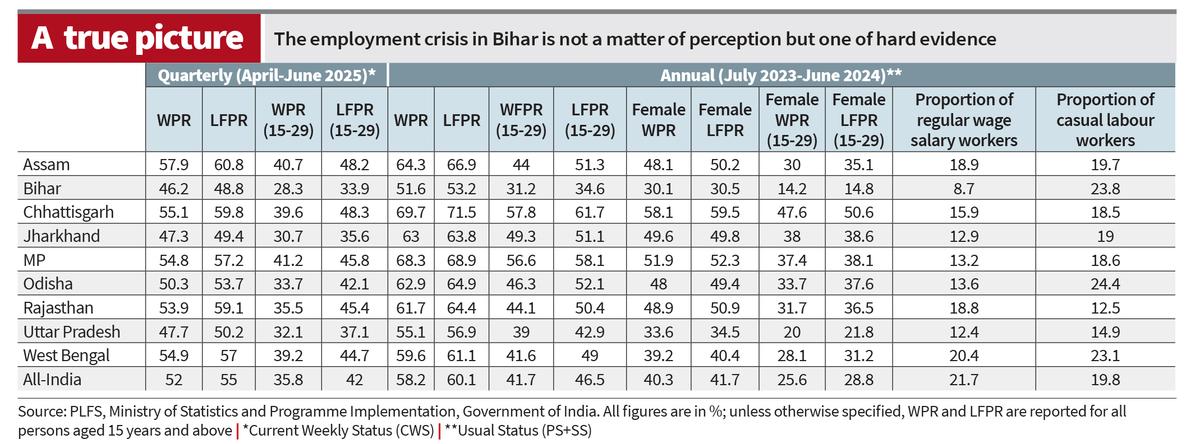Unemployment has consistently emerged as one of the most pressing political issues in Bihar. In the last two Assembly elections, jobs and livelihood were among the top concerns. In 2015, post-poll surveys conducted by Lokniti-CSDS showed that ‘unemployment/jobs’ was the most important issue for 9.1% of voters. By 2020, this percentage rose to nearly 21.0%, making it the second most important issue for voters. With the employment scenario still grim, it is an issue that is likely to dominate voter priorities in the forthcoming polls.
The situation needs to be looked at objectively, for which official statistics are useful. Under the Periodic Labour Force Survey (PLFS), the latest State-level indicators on employment are the April-June 2025 quarterly report and the July 2023-June 2024 annual report, with insights on Bihar.
Looking beyond the unemployment rate
The quarterly and annual releases cite Bihar’s unemployment rate as 5.2% and 3%, respectively, whereas it was 5.4% and 3.2%, respectively, at the national level for ages 15 and above. To the casual reader, Bihar’s employment/unemployment picture seems decent to good. However, such a superficial reading is misleading. To truly understand employment conditions, one must understand three interrelated indicators in the PLFS — Worker Population Ratio (WPR) or share of the population that is employed; Labour Force Participation Rate (LFPR) or the share of the population either employed or actively seeking work, and Unemployment Rate (UR) or share of the labour force that is unemployed and actively looking for work.
Looking at the UR in isolation conceals the true picture. The same quarterly and national releases cite the WPR for Bihar at 46.2% and 51.6%, respectively while the national WPR is 52% and 58.2%, respectively, which shows that the share of those employed in the working age population is much lower in Bihar.
On checking the WPR and LFPR in the table, Bihar has low WPR, low LFPR, and therefore low UR. A more holistic interpretation is grim because many in Bihar are not working (low WPR), and many are not even looking for work (low LFPR). Since those not working are not even looking for work, the unemployment rate looks deceptively low. This is a classic manifestation of the “Discouraged Worker Effect” wherein people without jobs lose hope of finding employment opportunities and completely withdraw from the labour force

A comparison of Bihar with similar/comparable States strengthens the inference and shows how bad employment conditions are in Bihar. But it is important to compare Bihar against States of a similar size and economic background. In this, two factors are crucial in determining similarity: population and per capita income.
For a meaningful comparison, Bihar was grouped with nine large, low-income States (population above three crore as in the Registrar General of India’s 2024 projections, per capita income below national average for 2025-25).
There are nine States that fall under this criteria, which are Assam, Bihar, Chhattisgarh, Jharkhand, Madhya Pradesh, Odisha, Rajasthan, Uttar Pradesh and West Bengal.
When Bihar’s indicators are compared with the chosen group of States, the results are alarming. Bihar ranks the lowest across WPR and LFPR. Uttar Pradesh fares marginally better but still hovers near the bottom.
The quarterly PLFS (April-June 2025) shows that among youth (15-29 years), the picture is even bleaker: only 28 out of 100 are working. Bihar is at the bottom in terms of youth work participation and youth labour force participation. For a generation that should be building its future, the doors of employment remain closed.
Since quarterly figures may be influenced by seasonal fluctuations in employment, it is important to look at the annual PLFS estimates as well. Quarterly estimates are based on Current Weekly Status, in which the reference period used to determine a person’s employment status is just seven days.
The annual report also presents Usual Status: principal+subsidiary status, or figures which give a more comprehensive and stable picture of employment over a long term, minimising the distortions caused by short-term variations such as festivals, illness or crop cycles. It also captures people’s subsidiary work. However, these annual figures too reinforce the same conclusion. For those aged 15 years and above, Bihar’s WPR stands at 51.6% and LFPR at 53.2%, which are abysmally low. Only Bihar and Uttar Pradesh fall below 60% in WPR.
The situation is grave for women. Bihar’s female WPR is only 30.1%, or out of 100 women aged 15 years and above, only 30 are working. The situation is even more distressing for young women. In the 15-29 age group, Bihar’s female work participation rate stands at 31.2%, while neighbouring Jharkhand records 49.3%, which is nearly 20 percentage points higher.
The quality of jobs in Bihar is equally troubling. Only 8.7% of workers are engaged in regular wage/salaried jobs, the lowest among comparable States. Bihar is the only State — not just in this group but also in the entire country — with a single digit proportion. At the same time, 23.8% of workers are employed as casual labourers, the highest share after Odisha across these States. This indicates a lack of secure and formal employment opportunities.
Such outcomes are in stark contrast to the claims of the National Democratic Alliance, which often highlights the formalisation of the economy as one of its achievements. In Bihar, however, the labour market remains overwhelmingly informal, insecure and poorly remunerated.
Migration and the missing numbers
A caveat must be kept in mind while interpreting Bihar’s employment indicators. The PLFS counts only those individuals residing in the State during the reference period. The employment picture could have been better had the PLFS been capturing migration as well.
The grim labour market outcomes cannot be separated from Bihar’s governance record. Chief Minister Nitish Kumar’s government has failed to improve literacy and human capital formation. The same PLFS (annual) shows Bihar’s literacy rate at only 73.2% for the 5-plus age group, which is far below the national average. Without significant improvements in education and skills, the State cannot hope to generate meaningful employment opportunities.
Despite frequent announcements, investment summits and promises of industrial revival, little has materialised on the ground. Mr. Kumar’s political manoeuvres and shifting alliances have yielded little tangible benefits for Bihar’s economy. The State has underperformed be it education, job creation, industrialisation and formalisation.
The employment crisis in Bihar is not a matter of perception but one of hard evidence. PLFS data consistently reveal that Bihar lags in all key labour market indicators. Mr. Kumar’s tenure of nearly two decades as the Chief Minister has failed to address these structural weaknesses. For a State with such a young population, this represents not just a missed opportunity but a potential social crisis in the making.
Bihar urgently needs a comprehensive strategy to revive education, create formal jobs, and stem the outmigration of its workforce. Anything short of this risks perpetuating the cycle of poverty, migration, and underdevelopment that has long haunted the State.
Jignesh Mevani is a Member of the Legislative Assembly in Gujarat and Convener at the Rashtriya Dalit Adhikar Manch
Published – October 11, 2025 12:16 am IST
